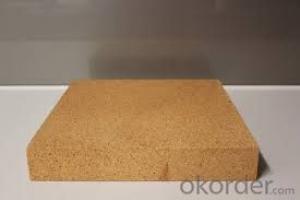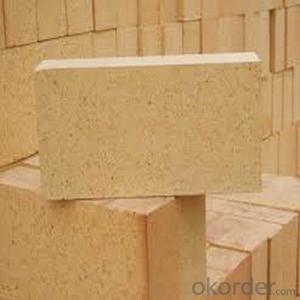High Alumina Bricks for Industrial Furnace - High Alumina Refractory Bricks
- Loading Port:
- Qingdao
- Payment Terms:
- TT OR LC
- Min Order Qty:
- 10 m.t
- Supply Capability:
- 1500 m.t/month
OKorder Service Pledge
OKorder Financial Service
You Might Also Like
Brief Description for High Alumina Refractory Bricks for Industrial Furnace
CMAX high alumina bricks are classified according to alumina content ranging from 48% to 90%.
CMAX high alumina bricks are commonly used in blast furnace, hot blast furnace, the roof of electric furnace, teeming ladle, rotary kiln, regenerator, etc.
Brief features for high alumina bricks
Low thermal conductivity
Excellent acid and base slagging resistance
High refractoriness
Excellent thermal shock resistance
Excellent mechanical strength
Good spalling resistance and wear resistance.
Good corrosion resistance.
High-temperature creep rate is quite low.
Good volume stability at high temperature.
Low bulk density, low thermal conductivity, good thermal insulation performance.
Technical data for high alumina bricks
| ITEM | UAL48 | UAL55 | UAL65 | UAL75 | UAL80 |
| Refractoriness, ℃ | 1750 | 1770 | 1790 | 1790 | 1810 |
| Apparent Porosity,% | 22 | 22 | 23 | 23 | 20 |
| C.C.S. Mpa | 39 | 44 | 49 | 53 | 55 |
| Refractories Under Load (0.6)℃ | 1420 | 1470 | 1500 | 1520 | 1500 |
| Reheating Linear Change (%) 1550℃×2h | 0.1 ~-0.4 | 0.1 ~-0.4 | 0.1 ~-0.4 | 0.1 ~-0.4 | -0.5~+0.5 |
| Chemical Composition (%)Al2O3 | 48 | 55 | 65 | 75 | 80 |
Images/photographs for high alumina bricks



FAQ
Q1:Are you a manufacture or trader?
A:Factory+trade(mainly factories,at the same time,we operates other related products).
Q2:Can we visit your factory?
A:Sure,welcome at any time,seeing is believing.
Q3:What's the MOQ of trial order?
A:No limit,We can offer the best suggestions and solutions according to your condition.
Q4:Which payment terms can you accept?
A:T/T,L/C are available for us.
Q5:After an order is confirmed,when to deliver?
A:15-25days after deposit.
Q6:Is your company accept customization?
A:We have own factory and excellent technical team,and we accept OEM service.
Q7:How about your company's certification?
A:ISO9001 and Test Report,also we could apply other necessary certification.
Q8:How to slove the quality problems?
A:If the products are not confirmed to customer samples or have quality problems,our compay will be responsible to make compensation for it.
Q9:Can you offers samples?
A:Of coures,samples are free but freight paid by the buyers.
Q10:What is the service life of your bricks?
A:The service life of different bricks is unlike.It also depends on your using condition and method.
- Q: What is the standard size of high alumina brick?
- Standard brick: 230 x 115 x 65; four points: 230 x 115 x 40; three points: 230 x 115 x 30; 150 x 120: Brick gable. Light weight brick 1 to 1.7 kilograms; heavy clay superscript brick weighs 3.75 kilograms; light 30 plates 0.79 kilograms; light 40 plates, 1.05 kilograms.
- Q: What are the specific raw materials for plastic pallets?
- With excellent mechanical properties, its strength and elasticity are higher than HDPE, and it has good flexural fatigue resistance. It has good heat resistance and good chemical stability. Besides being concentrated by concentrated sulfuric acid and concentrated nitric acid, it is relatively stable to other chemical reagents. The high frequency insulation performance of polypropylene is excellent because of its almost no water absorption, so the insulation performance is not affected by temperature.
- Q: What are the reasons for the decline in the performance of high alumina bricks when we use high alumina refractory bricks?
- The brick Pei boring and time. 6, Pei brick kiln installed between the brick and the brick Pei order, Pei and kiln top, kiln wall gap etc.. 7, high alumina brick kiln plan, and the lack of edges and corners of the scene should be avoided.
- Q: What is the price of the first grade high alumina brick?
- Many factories in Xinmi have high alumina bricks, but they must choose a regular factory. Kuwait refractory level high aluminum brick price at around 1600, the quality of double stable supply
- Q: How much is one ton / ton of high alumina refractory brick?
- The price of high alumina refractory bricks is not equal, according to the quality index of GB2988-2012
- Q: How to distinguish the good or bad of the high aluminum brick?
- Weigh the weight of the next block. According to the weight standard, a high alumina brick is 3.9 kg in weight, two in high alumina brick, three in high aluminium brick and 4.5 kg in 4.2. The same grade, the same type of high alumina brick, if the weight of a single brick to this standard, but for high quality high alumina brick, otherwise, can not reach such a weight, it shows good quality. If there is a crack, a large piece of broken angle, four sides of inequality, it is for substandard products.
- Q: Refractory brick, high alumina brick, magnesia chrome brick, magnesia brick, clay brick, which type of high temperature refractory brick?
- High alumina brick clay brick up to 1700 degrees above 1500 degrees -1750 degrees of magnesia brick and magnesia chrome brick 1500-1650 degrees, I is the production of clay brick, brick my temperature at 1500-1700 degrees. Specific depends on what kiln, brick is only part of it
- Q: How to test the aluminium bricks of high alumina refractory bricks?
- Before making bricks, the raw materials are usually tested and tested to see if the aluminum content is up to standard
- Q: Use of high alumina refractory bricks?
- High alumina brick refractory than clay refractory bricks and brick refractory degree are higher, up to 1750~1790 DEG C, which belongs to high-grade refractory materials.
- Q: What is the high temperature limit of refractory bricks and refractory soil?
- Fire clay -- usually refers to folk point stove furnace set with a kind of soil, limit under atmospheric pressure of 1500 degrees fire clay soil 1, properties and uses: clay brick of weak acid refractory material, its thermal stability is good, suitable for hot blast furnace, boiler and flue, smoke chamber lining, etc..2, product specifications form: standard shape, general, special-shaped and special-shaped brick. Physical and chemical properties of fireclay bricks.
Send your message to us
High Alumina Bricks for Industrial Furnace - High Alumina Refractory Bricks
- Loading Port:
- Qingdao
- Payment Terms:
- TT OR LC
- Min Order Qty:
- 10 m.t
- Supply Capability:
- 1500 m.t/month
OKorder Service Pledge
OKorder Financial Service
Similar products
Hot products
Hot Searches
Related keywords



























